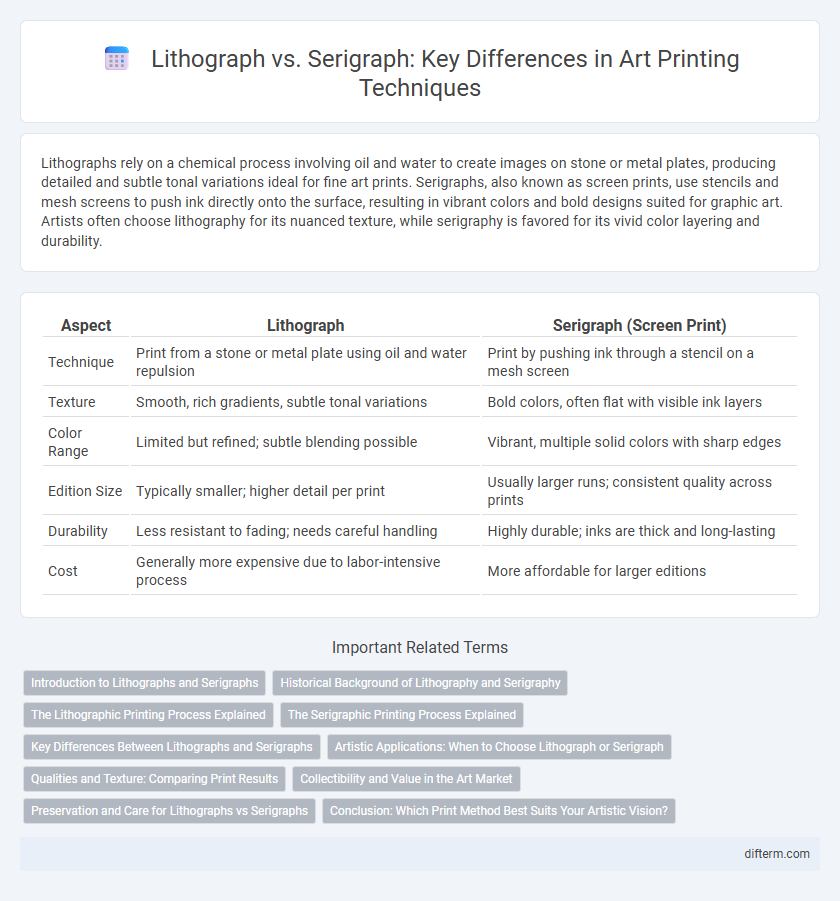Lithographs rely on a chemical process involving oil and water to create images on stone or metal plates, producing detailed and subtle tonal variations ideal for fine art prints. Serigraphs, also known as screen prints, use stencils and mesh screens to push ink directly onto the surface, resulting in vibrant colors and bold designs suited for graphic art. Artists often choose lithography for its nuanced texture, while serigraphy is favored for its vivid color layering and durability.
Table of Comparison
| Aspect | Lithograph | Serigraph (Screen Print) |
|---|---|---|
| Technique | Print from a stone or metal plate using oil and water repulsion | Print by pushing ink through a stencil on a mesh screen |
| Texture | Smooth, rich gradients, subtle tonal variations | Bold colors, often flat with visible ink layers |
| Color Range | Limited but refined; subtle blending possible | Vibrant, multiple solid colors with sharp edges |
| Edition Size | Typically smaller; higher detail per print | Usually larger runs; consistent quality across prints |
| Durability | Less resistant to fading; needs careful handling | Highly durable; inks are thick and long-lasting |
| Cost | Generally more expensive due to labor-intensive process | More affordable for larger editions |
Introduction to Lithographs and Serigraphs
Lithographs are created using a printing process that involves drawing an image onto a flat stone or metal plate with a grease-based medium, allowing for detailed and fluid lines. Serigraphs, also known as screen prints, use a stencil and mesh screen to apply layers of ink through a fine screen, producing vibrant and textured color fields. Both techniques are popular in fine art for their unique textures and are valued for their ability to produce multiple original prints.
Historical Background of Lithography and Serigraphy
Lithography, invented by Alois Senefelder in 1796, revolutionized printmaking by using a flat stone or metal plate to create images through oil and water repulsion, becoming a favored technique for artists in the 19th century. Serigraphy, also known as screen printing, emerged in the early 20th century with roots in traditional stenciling methods and evolved as a popular art form by the 1930s, particularly embraced by the American Silk Screen Artists. Both techniques have profoundly influenced modern art, with lithography enabling fine tonal gradations and serigraphy offering vibrant color layering possibilities.
The Lithographic Printing Process Explained
The lithographic printing process relies on the principle that oil and water repel each other, using a flat stone or metal plate where the image is drawn with a greasy substance. When the plate is moistened, the non-image areas retain water while the grease attracts the ink, allowing for precise transfer onto paper. This method contrasts with serigraphy, which uses a stencil and screen mesh to apply ink directly.
The Serigraphic Printing Process Explained
The serigraphic printing process, also known as screen printing, involves pushing ink through a fine mesh screen stencil onto a surface, allowing for vibrant and long-lasting prints. This technique differs from lithography, which relies on the chemical repulsion between oil and water on a flat stone or metal plate to transfer ink. Serigraphy offers rich color saturation and texture variation, making it a preferred method for artists seeking bold, dynamic artwork with exceptional durability.
Key Differences Between Lithographs and Serigraphs
Lithographs are created through a chemical process involving a flat stone or metal plate, where images are drawn with a greasy substance and then inked to adhere only to the drawing, allowing for detailed, tonal variations. Serigraphs, also known as screen prints, use a stencil technique with a mesh screen to apply layers of ink, resulting in vibrant colors and bold, graphic shapes. Lithographs often emphasize subtle texture and shading, while serigraphs excel in producing crisp, saturated hues with a more tactile surface.
Artistic Applications: When to Choose Lithograph or Serigraph
Lithographs excel in capturing intricate detail and subtle tonal variations, making them ideal for fine art reproductions and detailed illustrations. Serigraphs offer vibrant colors and bold, graphic effects, favored in pop art and contemporary graphic prints. Artists choose lithographs for precision and texture, while serigraphs suit projects requiring vivid color saturation and layering.
Qualities and Texture: Comparing Print Results
Lithographs produce rich, smooth textures with subtle tonal variations due to the grease-based drawing process on limestone or metal plates. Serigraphs, or screen prints, offer vibrant, solid color blocks with a slightly raised surface, thanks to the stenciling and ink layering technique. The tactile quality of lithographs feels softer and more continuous, while serigraphs present a bolder, more textured finish ideal for striking graphic effects.
Collectibility and Value in the Art Market
Lithographs typically have higher collectibility due to their longer historical usage and association with renowned artists, enhancing their market value. Serigraphs, or screen prints, often appeal to contemporary collectors because of their vibrant colors and limited edition runs, which also bolster their worth. Both mediums offer distinct investment potentials, but provenance and edition size significantly influence final valuation in the art market.
Preservation and Care for Lithographs vs Serigraphs
Lithographs require careful handling to avoid surface abrasion and should be kept away from direct sunlight to prevent fading of the greasy ink. Serigraphs, created through screen printing with layers of pigment, exhibit higher durability and color longevity, making them more resistant to light and environmental damage. Both mediums benefit from acid-free matting and controlled humidity levels to preserve their integrity over time.
Conclusion: Which Print Method Best Suits Your Artistic Vision?
Lithographs offer artists rich tonal gradients and subtle textures ideal for detailed, nuanced works, while serigraphs provide vibrant, saturated colors perfect for bold, graphic designs. Selecting between lithography and serigraphy depends on your desired visual effect, color intensity, and edition size preferences. Understanding each technique's unique qualities ensures alignment with your artistic vision and enhances the impact of your prints.
lithograph vs serigraph Infographic

 difterm.com
difterm.com